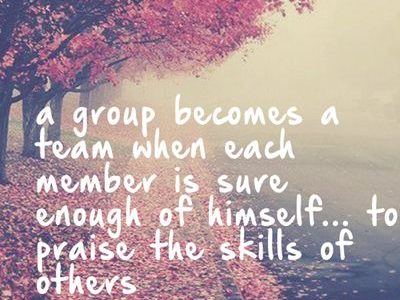Don’t underestimate the power of a good team in life or at work. Jobs can be challenging and our relationships with our co-workers can make it or break it. I really struggled when I started in my position 8 years ago because I was not integral to a team. My department was small and spread out at different locations. I was working independently and felt isolated and disconnected. It took awhile before I recognized that if I wanted a team, I would have to build it myself. I would have to select whom I wanted on my team and create a common purpose for us to build on. People do need to be connected to others to thrive.
So how do you build a good team? The only way I knew how to build a team was to do things outside of work. I created opportunities to come together and have some fun, find common ground, build trust and create friendships. Years later, I can say I have built a great team. We share good times and bad, sorrows and joys, we look out for each and most importantly make each other laugh.
I am invested in their lives and want success for them too. When we get together, we talk about how re-energized we are after our gatherings and ready to take on new challenges.
According to a February 28, 2016 NY Times article, there are two keys to good team building. “First, on the good teams, members spoke in roughly the same proportion, a phenomenon the researchers referred to as ‘‘equality in distribution of conversational turn-taking.” On some teams, everyone spoke during each task; on others, leadership shifted among teammates from assignment to assignment. But in each case, by the end of the day, everyone had spoken roughly the same amount. “As long as everyone got a chance to talk, the team did well,” Woolley said. “But if only one person or a small group spoke all the time, the collective intelligence declined.”
“Second, the good teams all had high ‘average social sensitivity’ — a fancy way of saying they were skilled at intuiting how others felt based on their tone of voice, their expressions and other nonverbal cues. One of the easiest ways to gauge social sensitivity is to show someone photos of people’s eyes and ask him or her to describe what the people are thinking or feeling — an exam known as the Reading the Mind in the Eyes test. People on the more successful teams in Woolley’s experiment scored above average on the Reading the Mind in the Eyes test. They seemed to know when someone was feeling upset or left out. People on the ineffective teams, in contrast, scored below average. They seemed, as a group, to have less sensitivity toward their colleagues.”
You can take the Mind in the Eye test here
The article concludes, “…that no one wants to put on a ‘‘work face’’ when they get to the office. No one wants to leave part of their personality and inner life at home. But to be fully present at work, to feel ‘‘psychologically safe,’’ we must know that we can be free enough, sometimes, to share the things that scare us without fear of recriminations. We must be able to talk about what is messy or sad, to have hard conversations with colleagues who are driving us crazy. We can’t be focused just on efficiency.”
In other words, we need to build trust and create friendships at work. To do that we must listen to each other, be kind, respect opinions, take turns and even have fun. We need to be sensitive and caring about each other’s welfare in order to create a great team.






It’s an honor to be part of your team. You are inspiring me to start my own blog – stories of non profit survival and triumph!